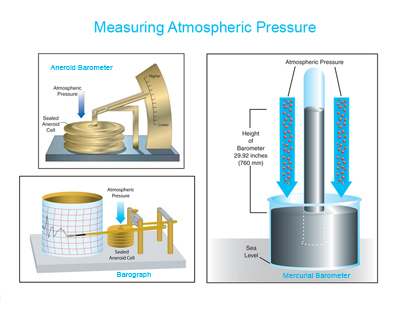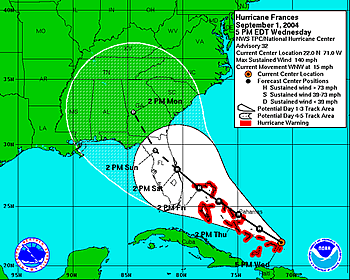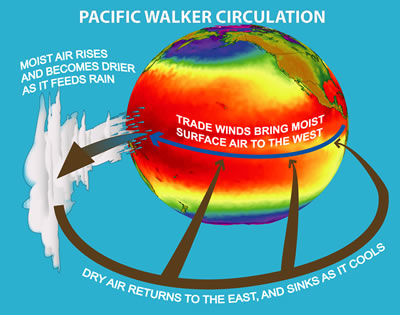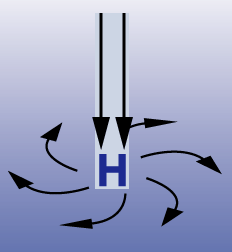The air moving away from the High pressure system leaves a “hole” to be filled, so air from above sinks into that “hole”.
Click on image for full size
Windows to the Universe original image
High Pressure Systems
You may have seen a
weather map with a blue H on it. This blue H denotes a high pressure system in that area of the map. Just what does that mean?
The H for high pressure systems and alternatively the L for low pressure systems are relative measures of the pressure in that particular system compared to the pressure around the system. There are no exact measurements that would make a particular system a High and another a Low. It's all relative!
The differences in pressure from one place to another on Earth are what cause wind. You see, air wants to move from areas of high pressure to areas of low pressure. Away from areas of high pressure and into areas of low pressure.
The Coriolis Force also adds rotation to the movement of air around pressure systems. In the Northern Hemisphere, air moves clockwise around a High and counter-clockwise around a Low. In summary, air moves away and clockwise from a High and into and counter-clockwise from a Low.
Now the air moving away from the High pressure system leaves a "hole" to be filled, so air from above sinks into that "hole". As the air sinks, it experiences an increase in pressure and an increase in temperature. Any water in the air tends to evaporate because of the increase in temperature. This means the water is not in the condensed form needed to make clouds and precipitation. That's why many people equate seeing a blue H on a weather chart with good weather and clear skies!
You might also be interested in:

Even though we can't see air, it is real and is made of up many molecules which are zipping around at astonishing speeds. Air molecules travel about 1,090 mph at the surface of the Earth. That said, all
...more
Wind is moving air. Warm air rises, and cool air comes in to take its place. This movement creates different pressures in the atmosphere which creates the winds around the globe. Since the Earth spins,
...more
Each year scientists make predictions about the strength of the upcoming hurricane season. To make seasonal hurricane predictions, scientists look at climate models and climate events that are known to
...more
The Walker circulation is an ocean-based system of air circulation that influences weather on the Earth. The Walker circulation is the result of a difference in surface pressure and temperature over the
...more
A barometer is a weather instrument used to measure atmospheric pressure. The first barometer was invented in 1643 by Evangelista Torricelli, one of Galileo's assistants. This first barometer used mercury
...more
Rainbows appear in the sky when there is bright sunlight and rain. Sunlight is known as visible or white light and is actually a mixture of colors. Rainbows result from the refraction and reflection of
...more
The Earth travels around the sun one full time per year. During this year, the seasons change depending on the amount of sunlight reaching the surface and the Earth's tilt as it revolves around the sun.
...more














